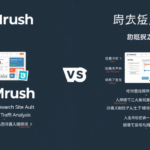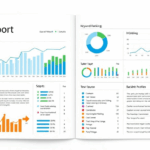Building Blog Strategy from Competitor Data That Actually Matters
Identifying Who Your Actual Competitors Are (Not Who You Think)
I’ve learned this the hard way more than once — the blogs you think are your rivals often aren’t the ones cannibalizing your traffic. Want to cry in real time? Throw your top URLs into Ahrefs or Semrush, and sort by overlap of ranking keywords. You’ll probably see some food blog called “Java for Jellybeans” outranking you for your Node.js deployment tutorial. Happens.
Two quick sanity checks:
- If a site shares less than 20% of your overlapping top 100 keywords, it’s noise. Not competition.
- If a site ranks with mostly generated content or scrapes, don’t pattern your efforts after theirs unless you enjoy sudden deindexing later.
Oh, one time I spent two weeks reworking my GCP tutorial to compete with a ~60 DA site. Turned out their traffic was just from one Reddit thread, not organic SEO. Total time sink.
Real competitors are stealing clicks *you had a shot at*. Not just clicks in your niche.
Dissecting Their Topic Clustering (Without Falling Into the Same Trap)
If your competitor blog has real traction, odds are good they’re using topic clusters — not always labeled as such, but you’ll see clusters around tools (“Cloudflare Workers”), vertical use cases (“AdSense for finance blogs”), or temporal trends (“TikTok traffic falloff”).
Start with their sitemap or RSS feed. Dump it into a spreadsheet, grab page titles and slugs. Then:
- Group by word stem (e.g. all URLs with ‘adsense’)
- Mark how many posts per stem in last 3–6 months
- Check internal linking density — easiest way is crawl with Screaming Frog and filter outbound internal links
Watch out for what I call “fragile clusters” — these are thin groups where a site posts a ton about blurry topics (like “AI ethics” or “creator economy”) but with no clear internal routing. They look like strategy but feel like flailing. Avoid that blueprint.
Extracting Topic Gaps Without Getting Lost in Volumes
Keyword gaps tools (Semrush, Ahrefs, etc.) are only semi-useful until you sanity check them. I once found over 180 “missing” keywords in a gap report — turned out 150 of them were typos of my competitor’s name. True story.
Here’s the quick-and-dirty method I now use that keeps things grounded:
- Export your keyword report — terms you rank for that bring traffic
- Export your competitor’s top keywords
- Use a JS array diff script to get the delta — I just run it in dev console
Then — and this matters — filter that list manually for anything that:
- You’ve already written about
- Is obviously mismatched to intent (you’re not going to outrank a product for its own name)
- Is trending-above-noise — use Google Trends to eliminate seasonal flukes
One thing I’ve found way too late sometimes: just because you’re not missing a keyword doesn’t mean you’re not missing the angle. You might need to say the same thing in a new format. Gallery, reference guide, interactive, cheat sheet — these trigger different behavior clusters in search results. Don’t just re-write. Re-frame.
When Caching, Page Speed, and Ad Load Time Skew Traffic Numbers
If you’re comparing yourself to a competitor who embeds AdSense or similar networks, beware: speed impacts analytics visibility. I only figured this out after wondering why one site with brutal layout shifts and massive CLS was still outranking me. Turns out, PageSpeed reports were distorted — mine had Cloudflare caching and preconnect logic, theirs didn’t.
But here’s the kicker: their revenue was probably double mine. Their slower load ended up delaying analytics beacons, sure — but it also maximized ad impressions by gating scroll longer. Really painful irony.
Undocumented edge case? If you run AdSense auto ads on a lazy-load’d infinite scroll blog, the second viewport jump often triggers an invalid impression (flagged, not counted, sometimes penalized if bounced). Caught this after setting up a synthetic click testing environment and nearly crying at my logs.
If you’re tracking competitor CTR or ad layout for strategy purposes, test it in two doms: [clean-dev] and [tracking-bloated]. See how their behavior differs under those conditions. It’s revealing — not flattering.
Tagging Systems: Intent Mapping vs. Junk Drawers
You ever pull structured data from a site and the tags are like: “JavaScript”, “TypeScript”, “JS”, “Node”, “ExpressJS”, “express”, “backend”, “cloud”? Welcome to taxonomic hell. That’s a major signal though.
If you scrape your competitor’s tag schema via sitemap or DOM selector (watch the pluralizations — one had /tag/javascript and /tags/javascript used on different posts, I kid you not), you can quantify how focused or scattered they are.
Look for:
- Tag redundancy (same topic, slightly renamed)
- Frequency cliff (most tags used once or twice?)
- Recency alignment (recent articles use recent tags?)
Aha moment for me was running a query across 20 competitor blogs to count how many tags were used more than 10 times in the last 180 days. Any blog with less than five: probably publishing spray-and-pray content. I don’t model anything off those.
How to Reverse Engineer Their Research Cycle
This one’s a little messy but wildly useful. Every solid blog has a rhythm — an 8-week prepare-publish-promote loop, give or take. The trick is catching theirs.
What worked for me: track publication timestamps on posts + first visible index date via Google search cache (or use the Wayback Machine for older stuff). Additionally, monitor their newsletter behavior or feed drops. Do they publish follow-up pieces within a month? Longform after shortform? Any marked series?
Then, monitor update behavior: one competitor I watched edited in a “2024 update” header on three of their most trafficked posts within 10 days of Google’s March core update. They weren’t adding content — they were staying visible.
Very common behavioral bug: RSS feeds claiming a new article when it’s just a title tweak. Screws with your change diffing logic unless you start storing full HTMLs along with metadata.
Dealing With Paywalled, Scraped, or AI-Padded Results
Classic issue: you analyze SERPs, find a strong ranking URL, throw it in your browser… and hit a paywall or low-effort AI slurry. Doesn’t mean it doesn’t need analyzing — in fact, it’s probably easier to outperform.
If it’s behind a paywall but indexed: Google is getting a previewable version. View Page Source, look for data-nosnippet, or inject in DevTools console:
[...document.querySelectorAll('*')]
.filter(n => n.textContent?.match(/w+/) && n.offsetParent !== null)
.map(n => n.textContent)
.join(' ')
.slice(0, 1000)If AI-generated: use string frequency and paragraph repetition logic — GPT-style content tends toward topic noun repetition every X tokens. I sniff that out with a basic entropy checker and a substr count.
Once, I made the mistake of modeling a content outline off an article that looked high-effort… until I dug a little and found 14 paragraphs with identical topic syntax and no outbound links. It dropped entirely off search three weeks later. Lucky I hadn’t published yet.
Which Content Angle Actually Triggers Backlinks and Shares
Competitors use flashy headers (“Ultimate”, “Unbeatable”, “2024 Ready”) all the damn time — but those often don’t translate to links. What does? Utility + specificity.
Run this: take your competitor’s posts, pull their known backlinks from Ahrefs, and sort by number. Then manually classify the top 20 linked articles by angle:
- Data analysis
- Original research
- Cheat sheet / quick reference
- Free tool or calculator
- Strong opinion / contrarian piece
I once got five high-DA links on a throwaway calculator that just estimated how long your blog would keep ranking after last update. It was useful — not optimized.
The behavioral bug is this: nice-looking summaries rarely get linked unless they’re cited by another blog writing something meatier. Middle-of-funnel fluff is not a backlink magnet.














